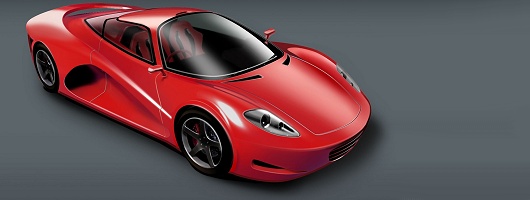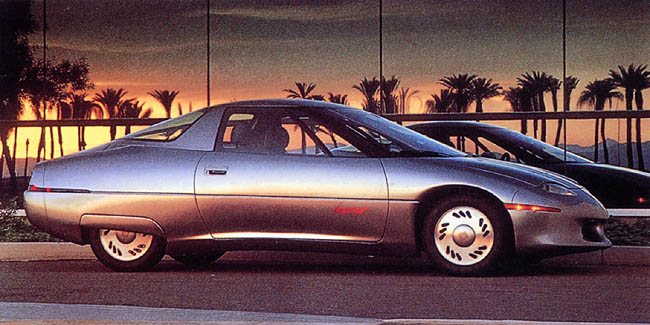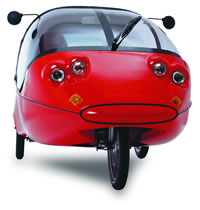

Venturi has finally revealed the successor to the Venturi Fetish and they do not disappoint. Working closely with Michelin, they designed a car that redefines the traditional concept of a vehicle. Instead of connecting wheels to a motor and chassis, Venturi and Michelin miniaturized the electric motors and suspension and put them inside every wheel:

The Volage body is basically carbon fiber wrapped around the battery for optimum aerodynamics. The driver will be sitting inside a tub that is the battery and its components, as you can see here:

The Volage will have a top speed of 93 mph and a 0-60 in under 5 seconds. It’s not quite as fast as it looks, but it will feature cutting edge technology. The driver will be able to customize the drive settings for speed, economy, or comfort. Each vehicle will be created by hand and the price will most likely be around half a million dollars. You can find out more at the Venturi Volage website.
PRESS RELEASE:
VENTURI VOLAGE
WORLD PREMIERES
The result of close technological collaboration between Venturi Automobiles and Michelin, the Venturi Volage, presented for the first time at the “Mondial 2008” (Paris Motor Show), marks a major step forward in the evolution of the Automobile. This new Venturi incorporates innovations which have enabled radical changes in terms of the vehicle’s architecture, style, dynamic behaviour and, more generally, the design of a modern vehicle.
All these changes constitute several world premières which, with the presentation of the Venturi Volage, reinforce Venturi’s capability for constant innovation, as well as its position as the most advanced company in the field of electric vehicles.
POWER TRANSMISSION & ACTIVE SUSPENSION
With 4 drive wheels with active suspension, the Venturi Volage has no equivalent. “Michelin Active Wheel” technology in fact incorporates 2 electric motors per wheel (1 for suspension and 1 for drive), ie. a total of 8 electric motors piloted in real time by spearhead electronics.
Like the mechanism of a watch, all the components, motors, gear reduction units and suspensions, are miniaturized and built into the wheels.
The active electric shock absorber system allows for total adaptation to the type of road surface and driving. Combining Michelin’s experience in the area of surface liaison with that of Venturi for the chassis, the Venturi Volage represents in its road holding, drivability and silent functioning, the summum of today’s automotive technology.
THE CAR OF THE DIGITAL ERA
Playing down the mechanical aspect in favor of electronics, close to the concept of a robot, this car belongs to a new era, the digital era. Thanks to a dashboard touch screen, the driver can configure the vehicle entirely as he wishes. This total control marks significant progress in terms of management, particularly of the energy stored in the car’s batteries: the driver can, for example, decide to give preference in certain cases to range rather than power, comfort rather than speed, an important factor for an electric car.
A CHASSIS UNIQUE WORLDWIDE
The only part that the Venturi Volage shares with the Venturi Fétish is its carbon fiber bodywork. Developed by the Venturi Design Office, this body is still a unique concept worldwide, as it is the only one to have been specifically designed to be that of an electric car and thus carry batteries within its very structure.
Thanks to this innovative design, both the Fétish and the Volage benefit from an unequalled level of safety, for both the cars’ passengers and also the batteries they carry.
The ideal distribution of the Venturi Volage’s masses – 45% at the front, 55% at the rear – and its perfectly mastered weight of 1,075 kilos enable it to attain 100 km/hr (62 mph) in less than 5 seconds.
PRODUCTION MODELS
A real demonstration of spearhead technology, the car presented in its world première is entirely operational and prefigures the production of a limited series of this model, scheduled as from 2012.
Like the Venturi Fétish assembled in our workshops in Monaco, the Venturi Volage will be assembled by hand, in the form of very limited production.
The technological repercussions of these two cars positioned at the very top end of the market are to be found on other vehicles bearing the Venturi brand, enabling as many people as possible to benefit from the firm’s advances in the field of sustainable mobility.
DESIGN OF VOLAGE, BY SACHA LAKIC
“Like a light and sensual veil, the Volage’s bodywork clings close to its exceptional technical features.
Active suspensions and motors incorporated into the wheels, a flat bottom, aerodynamic tunnels: these choices and technological advances have enabled me to “design the void” usually occupied by the engine and suspensions, and thus explore audacious new paths in terms of styling.
The void is part of the Volage style; it has been designed by subtraction.
Volage has been fashioned by the wind.
The science of aerodynamics is the main tool that has been used to elaborate its shape.
It is easy and enjoyable to imagine the movement of flows of air, on and across its bodywork.
Volage finds itself in a totally original and decidedly contemporary formal category. The relationship with Venturi’s other models is obvious, though it is also possible to see, in a few details, a subtle tribute to certain icons among French cars of the pre-war era, the most elegant, the ones that were way before their time. Volage inspires passion: its powers of seduction are immense.”
PRESS RELATIONS
Marianne HOLLANDE / Clément DORANCE
Email : press@venturi.fr
M : +33.6.78.63.23.52
Venturi Automobiles
Ph : +377 99 99 52 00
Fax : +377 99 99 52 01
THE WORLD OF VENTURI
The Venturi stand is certified « BILAN CARBONE »:
Venturi presents its new range at the “Mondial de L’Automobile 2008” on its stand of 500 m2 in Hall 5/1. The creation of the stand, just like our participation in this event, is certified “Bilan Carbone” which means that all emissions of CO2 connected with our activity have been compensated for.
Our industrial partners :
– MICHELIN Group for the Venturi Volage
– PSA Group for the Berlingo “Powered by Venturi”
– ZEBRA batteries for the Berlingo “Powered by Venturi”
Our partners for the Mondial are:
– The company VESTAS, N°1 in modern energy
– AUTODESK, world leader in 2D and 3D application software
– Our models wear STELLA MC CARTNEY’s dresses
Website:
With the arrival of its new vehicles Volage and Eclectic, Venturi is launching its new dedicated sites www.venturivolage.fr and www.venturieclectic.fr
Venturi spin-off products (including the “Black Feather” longboard www.venturiboards.com) are available from the on-line boutique on the website.











